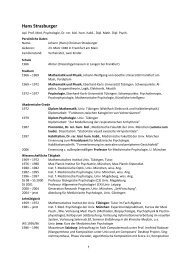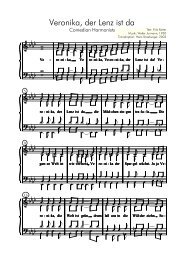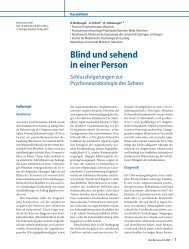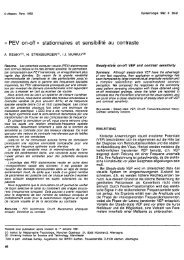Peripheral vision and pattern recognition: a review - strasburger - main
Peripheral vision and pattern recognition: a review - strasburger - main
Peripheral vision and pattern recognition: a review - strasburger - main
You also want an ePaper? Increase the reach of your titles
YUMPU automatically turns print PDFs into web optimized ePapers that Google loves.
<strong>Peripheral</strong>_Vision.doc<br />
4.2.2 Spatial-frequency characteristics of letter identification<br />
To underst<strong>and</strong> mechanisms underlying letter <strong>recognition</strong>, the concept of perception as a noiselimited<br />
process (Barlow, 1977; Legge & Foley, 1980; Pelli, 1981) has been applied to letter<br />
<strong>recognition</strong> (Sperling, 1989, Parish & Sperling, 1991, Solomon & Pelli, 1994, Majaj, Pelli,<br />
Kurshan, & Palomares, 2002). Parish <strong>and</strong> Sperling (1991) embedded b<strong>and</strong>-pass filtered<br />
versions of the 26 letters of the alphabet in identically filtered Gaussian noise <strong>and</strong> averaged<br />
performance over these letters. Observers used best (42% efficiency) spatial frequencies of 1.5<br />
cycles per letter height over a 32:1 range of viewing distances. Solomon <strong>and</strong> Pelli (1994)<br />
presented the 26 letters unfiltered but masked by high- or low-pass noise. Unlike Parish <strong>and</strong><br />
Sperling (1991) they obtained filters of about 3 cycles per letter from both high- <strong>and</strong> low-pass<br />
data, <strong>and</strong> an observer efficiency of about 10%. Object spatial frequencies are now often used to<br />
characterize filtered letters. However, Petkov <strong>and</strong> Westenberg (2003) showed that the spectral<br />
specification in terms of cycles per letter rather than cycles per degree in Solomon <strong>and</strong> Pelli’s<br />
(1994) was misleading. Indeed, in the latter study letter stroke width had covaried with letter<br />
size. Conventional spatial frequency in cycles per degree therefore may still be the most<br />
appropriate measure for the <strong>recognition</strong> of letters as well as of the non-symbolic <strong>pattern</strong>s to<br />
which Petkov <strong>and</strong> Westenberg had extended their study.<br />
Performance levels for letter identification in central <strong>and</strong> peripheral <strong>vision</strong> were directly<br />
compared by Chung, Legge, <strong>and</strong> Tjan (2002). They found spatial frequency characteristics of<br />
letter <strong>recognition</strong> to be the same in the two viewing conditions. Chung <strong>and</strong> Tjan (2009) used<br />
similar techniques to study the influence of spatial frequency <strong>and</strong> contrast on reading speed, in<br />
the fovea <strong>and</strong> at 10° eccentricity. At low contrast, speed showed tuning effects, i.e., there was<br />
an optimum spatial frequency for reading. The spatial-frequency tuning <strong>and</strong> scaling properties<br />
for reading were rather similar between fovea <strong>and</strong> periphery, <strong>and</strong> closely matched those for<br />
identifying letters, particularly when crowded.<br />
4.2.3 Contrast thresholds for character <strong>recognition</strong><br />
First measurements of contrast thresholds for peripheral form <strong>recognition</strong> were performed with<br />
the Tübinger perimeter using a diamond vs. circle discrimination task (Aulhorn, 1960, 1964;<br />
Aulhorn & Harms, 1972; Johnson, Keltner, & Balestrery, 1978; Lie, 1980), <strong>and</strong> by Fleck (1987)<br />
for characters displayed on a computer terminal. Herse <strong>and</strong> Bedell (1989) compared letter- to<br />
grating-contrast sensitivity at 0°, 5°, 10°, <strong>and</strong> 15° in two subjects on the nasal meridian.<br />
Eccentric viewing resulted in a larger sensitivity loss for letters than for gratings. In their Fig. 6,<br />
they plotted log contrast sensitivity versus hypothetical spatial frequency, using the rule-ofthumb<br />
relation cpd = 30/MAR, <strong>and</strong> obtained a linear dependency. If the abscissa is converted<br />
back to the actual data, hyperbolic functions similar to those in Figure 13 result.<br />
Strasburger et al. (1991) reported the first extensive contrast-threshold measurements for<br />
characters where retinal eccentricity <strong>and</strong> stimulus size were varied independently so as to<br />
42






